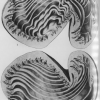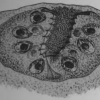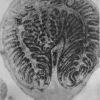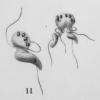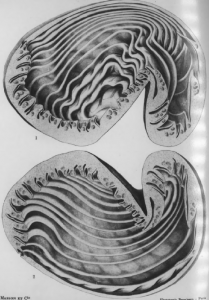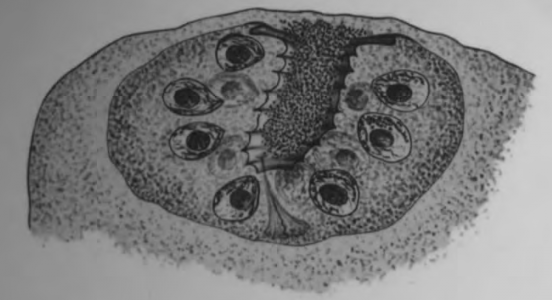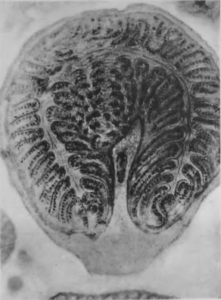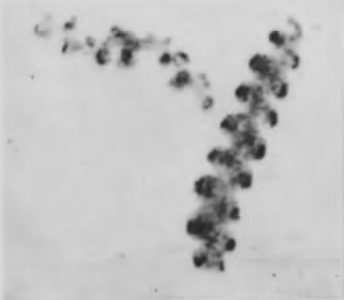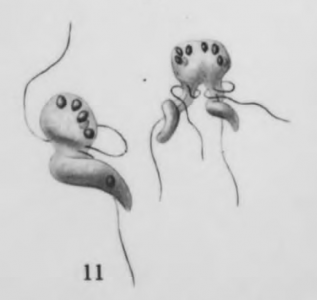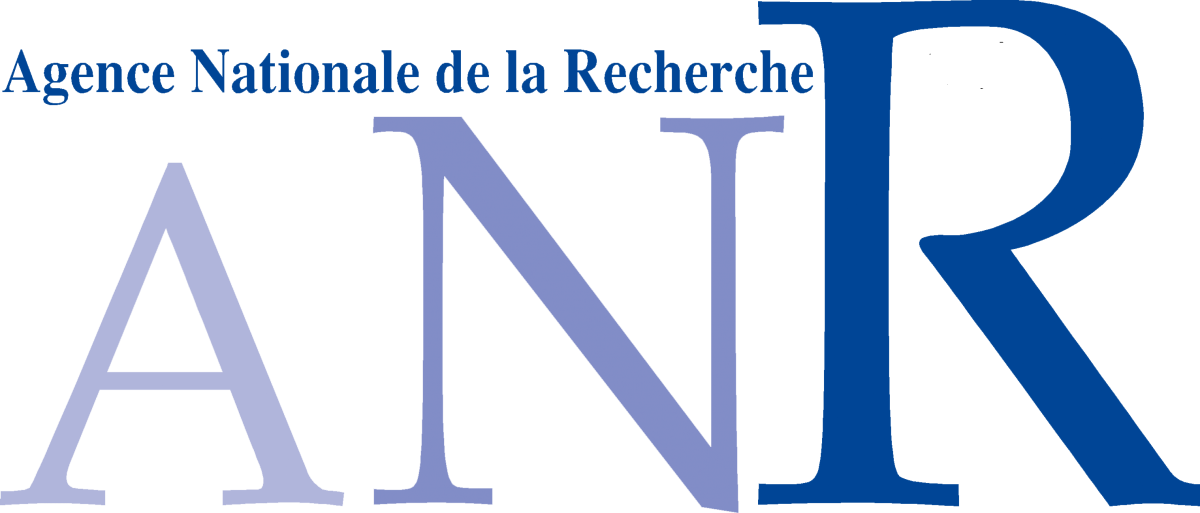Amoebophrya grassei
Diagnosis
Diagnosis_Genus: Amoebophrya Koeppen 1984. Intracellular parasites. Smallest trophonts observed have 3 µm long, a gymnodiniales form, with a large hypocone and a small rudimentary epicone. The hypocone broadens at its base and forms a cup-shaped circumvallation, turning in spiral. The hypocone starts to cover the epicone (in other word, the epicone becomes progressively invaginated into the hypocone, forming a cavity, the mastigocoel, which is a characteristic of the genus Amoebophrya. This mastigocoel remains open by a small aperture at the apex of the trophont. Sporogenesis starts rapidly during this transformation. The inner surface of the mastigocoel is furnished with helically coiled ridges as a result of a continuous lengthening of the previous dinospore girdle during the trophic growth. Along these ridges countless flagella are inserted. Flagella of future dinospores (the free-living stage of the parasite) are produced inside the mastigocoel. At the end of the intracellular maturation, flagella started to beat, and what was the epicone at the origin, directed through the aperture of the mastigocoel, moved forward. This evagination make the flagella outside the structure, which is now called the vermiform. This action breacks out the host membrane, releasing the vermiform outside. This vermiform is closed forward (at the epicone side), but open in the back. When release, this part forms a large digestive vacuole that contains what remains from the host. This vermiform considerably strechs out with time. The spore chain forming the vermiform rapidly separates to produce spores (gymnodinial shape), generally of two different sizes (macrospores and microspores). These spores have a large epicone and a reduced hypocone (the reverse of what is observed during the first stage of the trophont).
Diagnosis_species: Amoebophrya grassei Cachon 1964. Hyperparasite infecting Oodinium poucheti (only young individuals, less than 20 µm). Multiple infections are often observed, sometime with more than 12 trophonts per host, with different sizes. Only 1-3 trophonts will end their intracellular maturation. These parasites are cytoplasmic, they never penetrate into the nucleus. Nucleus are composed of 6 v-shaped chromosomes visible during the prophase and only at the end of the sporogenesis. When release, the vermiform produces a large digestive vacuole that contains what remains from the Oodinium host: pedoncule, nucleus, other trophonts of Amoebophrya in case of multiple infections. Other engulfed trophonts are generally digested. Some of them, however, may finalize their development and during their own evagination will include the first mature parasite. Both macrospores (5-6 µm long) and microspores (3.5 µm long) are produced. One trophont produces one spore type only.
Body_spores: 5-6 µm (macrospores)
Body_spores: 3-5 µm (microspores)
Type species
The type species (lectotype) for this genus is Amoebophrya acanthometrae Borgert 1897.
Type illustration / Type locality / Type specimen
Type_locality: Alger bay, Algérie.
Type_Host: Oodinium poucheti
Ecology
Substrate_spores: planktonic
Substrate_trophont: endozoic
Sociability_spores: solitary
Sociability_trophont: solitary
Sociability_trophont: colonial
Salinity: marine
Salinity: variable (estuary)
pH: neutral
Feeding: hyperparasitism (by phagotrophy)
Life cycle
Phases_alternance: haplontic
Generation: <1 month
Reproduction_mode: asexual
Symbiont: horizontal_active-penetration
Feeding behaviour
Mode of locomotion
Reference(s)
Observation site(s)
HOSTS
| Association with... | Region origin | Name of site | In reference... |
|---|---|---|---|
| Oodinium poucheti | Alger Bay |
(1964) Contribution à l’étude des péridiniens parasites. Cytologie, cycles évolutifs. Ann. Sci. Nat. Zool. 6:1-158. |
|
| Oodinium fritillariae |
(1964) Contribution à l’étude des péridiniens parasites. Cytologie, cycles évolutifs. Ann. Sci. Nat. Zool. 6:1-158. |







